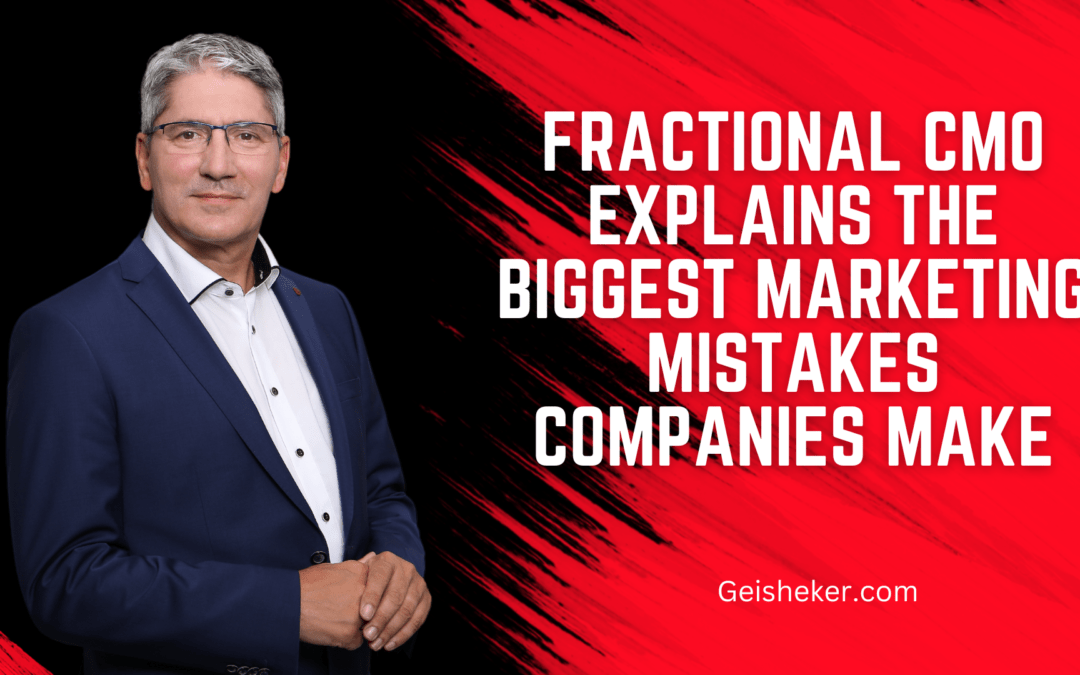Fractional CMO Video Interview transcription
Introduction
My name is Peter Geisheker, and I’m a fractional CMO. I’ve been working with B2B SaaS startups since about 2000, so I’ve handled pretty much every kind of marketing issue those companies face.
What is the biggest marketing mistake small to midsize companies make?
It’s always the same thing – are they focusing on a niche market or are they trying to be all things to everybody? The key today, especially if you don’t have a gigantic ad budget, is to focus on a niche market that has the biggest, most painful problem your product or service will solve.
When working with a new client, what are the biggest problems you focus on solving in the first month?
The first thing is always are they focused on a niche market and secondly, is their messaging clear to the point? Is it explaining the major problem they solve? Are they explaining the value and the benefits they provide, and are they doing it in a simple way? I always like to say if a 12-year-old can read it and understand it, it’s good. If they can’t, make it more simple.
Marketing messaging is successful when it’s simple
The great advertising master David Ogilvy, I believe, said this: ‘Nobody ever complained that something was too easy to understand.’
The number 1 mistake tech companies make with their websites
When somebody goes to your website and they have to read the opening paragraph two, three, four, five times to try to figure out what your company actually does – and in Tech I see this so often – where you just read their homepage, read their services page, and you’re like, ‘What do you do?’
What marketing problems do you focus on solving in the first 90 days when working with a new client?
Within the first 90 days, update the messaging focused on a niche market, a strong value proposition. If possible, try to get proof. Instead of saying, ‘Well, we make the greatest X,’ say, ‘We solve it 27% faster, 58% cheaper.’ Get some proof, get testimonials from clients. Just really update the sales messaging so people understand what you sell, the problem you solve, and how it will make their lives easier.
I always like to start with the website. Then, using that core messaging, I like to update the messaging in all of the online ads. You want your messaging to be consistent. You don’t want Facebook to say one thing, Google ads to say something completely different, and your website to say something different. You need really consistent messaging.
It’s not about your company. Here’s the only thing people care about
Everyone subscribes to the same radio station, WIIFM: ‘What’s in it for me?’ They don’t care about you; they don’t really care about your business; they don’t care about your founders. They care about, ‘I’ve got a problem that I want to have solved. Do you solve it?’
If you are selling B2B tech, you need to show ROI
This can be really difficult to do in Tech, but you can get this with case studies, and interviewing clients. What is your return on investment? People who sign the check to your company want to know, ‘Are we going to save more money? Are we going to make more money? How is our business going to be improved financially compared to the cost of what we are purchasing?’
My specialty is B2B, and such a big thing is, ‘Okay, if we spend 50 grand on your software solution, how long is it going to take for us to recoup that and for our investment to start to become profitable?’
Mistakes made by the C Suite at small to midsize companies
One thing they greatly overestimate is what their core marketplace thinks about their company, about their product or service. A lot of assumptions are made because, ‘Well, we’ve done a little advertising on LinkedIn or we’ve gone to one trade show, and automatically the world knows who we are and you’re on the top of their radar.’ The truth is, if we interview your target market, probably a solid 95% or more have never heard of you. They don’t know what you do; they don’t know what you sell.
The biggest marketing sin of them all
So many companies make the mistake of copying what their top competitors are saying. You don’t distinguish yourself as being different or special; you’re just another carbon copy doing exactly the same thing. You really need to show why you are unique, why you’re special. Apple computer does a wonderful job of this. You aren’t going to mistake Apple with Microsoft or IBM or Google. They do a tremendous job of showing we are different; we’re not the same as everybody else.
Yet so much of the tech industry blatantly copies each other. If you look at their ads, their websites, all you have to do is change the company logo, and they’re exactly the same.
Setting Goals
You absolutely must set measurable goals. A measurable goal isn’t saying, ‘We want to get as many leads as we can.’ Well, for some companies, as many leads as they can might be two a day; for another company, it might be 200 a day. Set measurable goals and within those goals, set time frames to achieve them. Say, ‘Well, we want to increase the amount of leads coming in from our current spend by 12% in 90 days.’ Things like that are workable. A goal like, ‘We want to have a better website,’ isn’t a measurable goal. Saying, ‘We want the website to increase in search engine rankings for these specific keywords,’ that’s a measurable goal. Saying, ‘We want to increase traffic by 10% over the next 90 days or 25% over the next 6 months,’ everything should be measurable and, to take that a step further, measurable to how does it impact sales. Because you might have a Facebook post or something that goes viral, but that’s great for ego. Did it impact the sales of the company?
Two Reasons why Peter will not work with some companies
One thing is they don’t have is any money. We all know the cliché, ‘It takes money to make money.’ If your business can barely afford a part-time fractional CMO, how are you going to afford a marketing team? How are you going to afford to advertise and, to out-market your competitors?
The second thing is having a CEO who wants to be the chief marketing officer. When you have your initial talks with them, you might say, ‘Well, some strategies I would consider are…’ ‘Well no, no, no, that’s really not a direction I want to go, or we tried that once, it does not work.’ If you’re bringing on a fractional CMO, you’re hiring somebody who is an expert, somebody who should know a lot more about marketing in your industry than you do. You’re hiring them to lead marketing; let them do their job. And as we mentioned previously, set measurable goals.
How to contact Peter Geisheker
If you are interested in hiring Peter Geisheker as your Fractional CMO, click on the button below or call (920) 318-0654.


